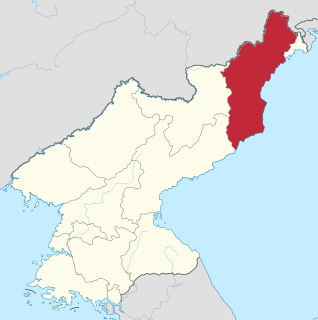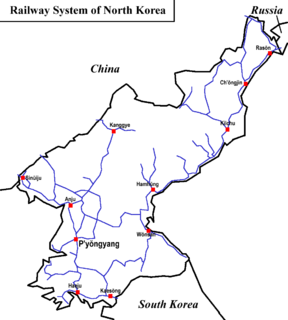
Rail transport in North Korea is provided by Korean State Railway which is the only rail operator in North Korea. It has a network of over 6,000 km of track, of which the vast majority is standard gauge; there is, however, nearly 400 km of narrow-gauge lines (762 mm) in various locations around the country.
Rajin Station is a railway station in Rajin-guyŏk, Rasŏn Special City, North Korea. It is the junction point and terminus of both the Hambuk and P'yŏngra lines of the Korean State Railway. It is also the starting point of a freight-only branchline to Rajin Port Station.
North Korea has a railway system consisting of an extensive network of standard-gauge lines and a smaller network of 762 mm (30.0 in) narrow-gauge lines; the latter are to be found around the country, but the most important lines are in the northern part of the country. All railways in North Korea are operated by the state-owned Korean State Railway.

The Kaech'ŏn Line is an electrified standard-gauge secondary line of the Korean State Railway running from Sinanju on the P'yŏngŭi Line to Kaech'ŏn on the Manp'o Line.

The Kangdŏk Line is an electrified standard-gauge secondary line of the North Korean State Railway running from Namgangdŏk on the P'yŏngra Line to Susŏng on the Hambuk Line.
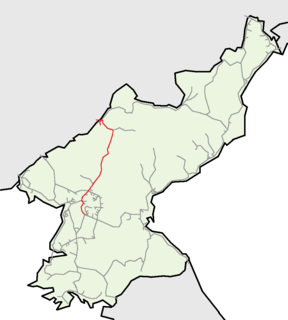
The Manp'o Line is an electrified standard-gauge trunk line of the North Korean State Railway running from Sunch'ŏn on the P'yŏngra Line to Manp'o on the Pukpu Line. The line continues on from Manp'o to Ji'an, China.

The Hambuk Line is an electrified standard-gauge trunk line of the Korean State Railway in North Korea, running from Ch'ŏngjin) on the P'yŏngra Line to Rajin, likewise on the P'yŏngra line.
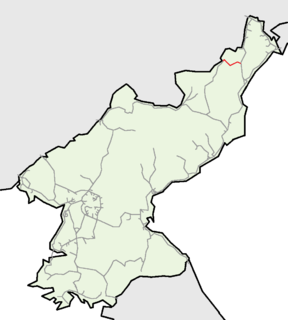
The Musan Line is an electrified standard-gauge secondary trunk line of the Korean State Railway in Musan and Puryŏng counties, North Hamgyŏng Province, North Korea, running from Komusan on the Hambuk Line to Musan, where it connects to the narrow-gauge Paengmu Line. The section from Komusan to Sinch'am is double tracked.

The Hoeryŏng T'an'gwang Line is a non-electrified standard-gauge freight-only secondary line of the Korean State Railway in North Korea, running from Hoeryŏng Ch'ŏngnyŏn on the Hambuk Line to Yusŏn.

The Kangwŏn Line is a 145.8 km (90.6 mi) electrified standard-gauge trunk line of the Korean State Railway of North Korea, connecting Kowŏn on the P'yŏngra Line to P'yŏnggang, providing an east–west connection between the P'yŏngra and Ch'ŏngnyŏn Ich'ŏn lines.
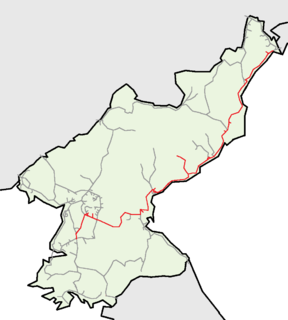
The P'yŏngra Line is an electrified standard-gauge trunk line of the Korean State Railway in North Korea, running from P'yŏngyang to Rajin, where it connects with the Hambuk Line. It is North Korea's main northeast-southwest rail line.
Komusan Station is a railway station in Komusal-lodongjagu, Puryŏng, North Hamgyŏng province, North Korea. It is the junction point of the Hambuk and Musan lines of the Korean State Railway.
Ch'ŏlsong Ch'ŏngnyŏn Station is a railway station in Ch'ŏlsong-ri, Musan county, North Hamgyŏng province, North Korea, on the Musan Line of the Korean State Railway. It is also the starting point of the freight-only Musan Mining Branch to Musan Kwangsan station.
Musan Station is a railway station in Musan-ŭp, Musan county, North Hamgyŏng province, North Korea, at the terminus of the Musan Line of the Korean State Railway. The narrow-gauge Paengmu Line from Paegam on the Paektusan Ch'ŏngnyŏn Line also terminates here.
Susŏng Station is a railway station in Susŏng-dong, Sŏngp'yŏng-guyŏk, Ch'ŏngjin-si, North Hamgyŏng, North Korea, on the Hambuk Line of the Korean State Railway.

Namyang Station is a railway station in Namyang-rodongjagu, Onsŏng county, North Hamgyŏng, North Korea, on the Hambuk Line of the Korean State Railway, and there is a bridge across the Tumen River, giving a connection to the Chinese railway network at Tumen, China via the Namyang Border Line.
The Domun Railway Company, was a privately owned railway company in Japanese-occupied Korea.

The Namyanggukkyŏng Line, or Namyang Border Line, is a 0.8 km (0.50 mi) long railway line of the Korean State Railway connecting Namyang on the Hambuk Line with Kukkyŏng at the DPRK–China border, continuing on to Tumen, China, 3.3 km (2.1 mi) from Namyang. At Tumen it connects with China Railway's Changtu Railway, Tujia Railway, and Tuhun Railway. The line is electrified between Namyang and Kukkyong.
The Sech'ŏn Line is an electrified 14.4 km (8.9 mi) long railway line of the Korean State Railway in North Korea, connecting Sinhakpo on the Hambuk Line with Chungbong.

